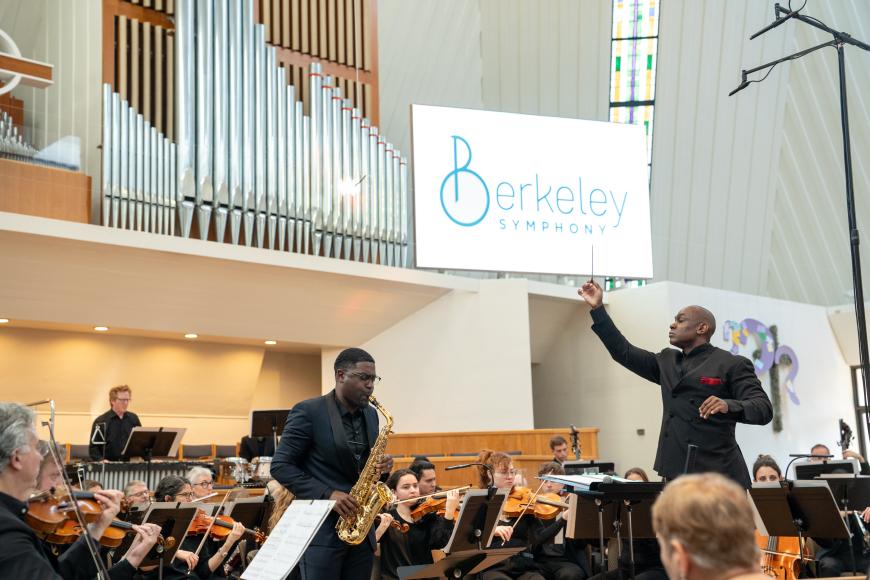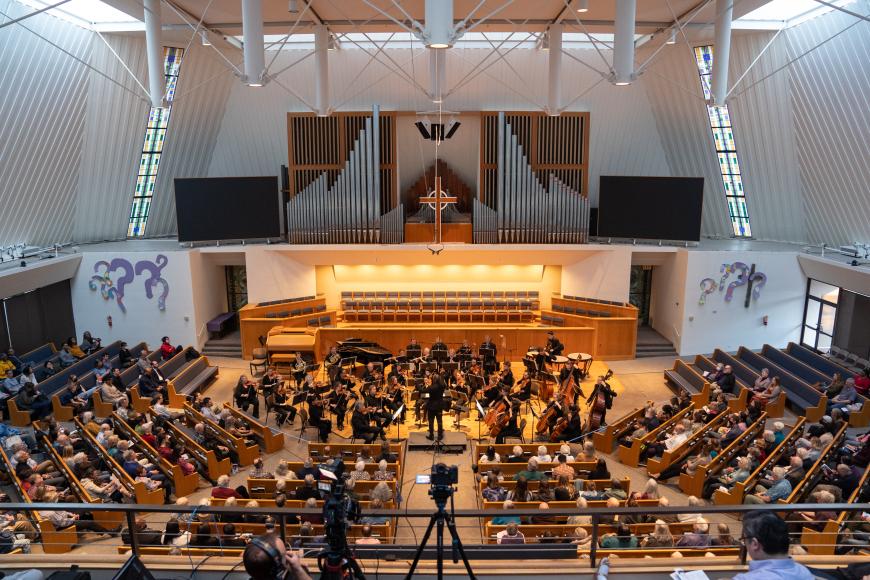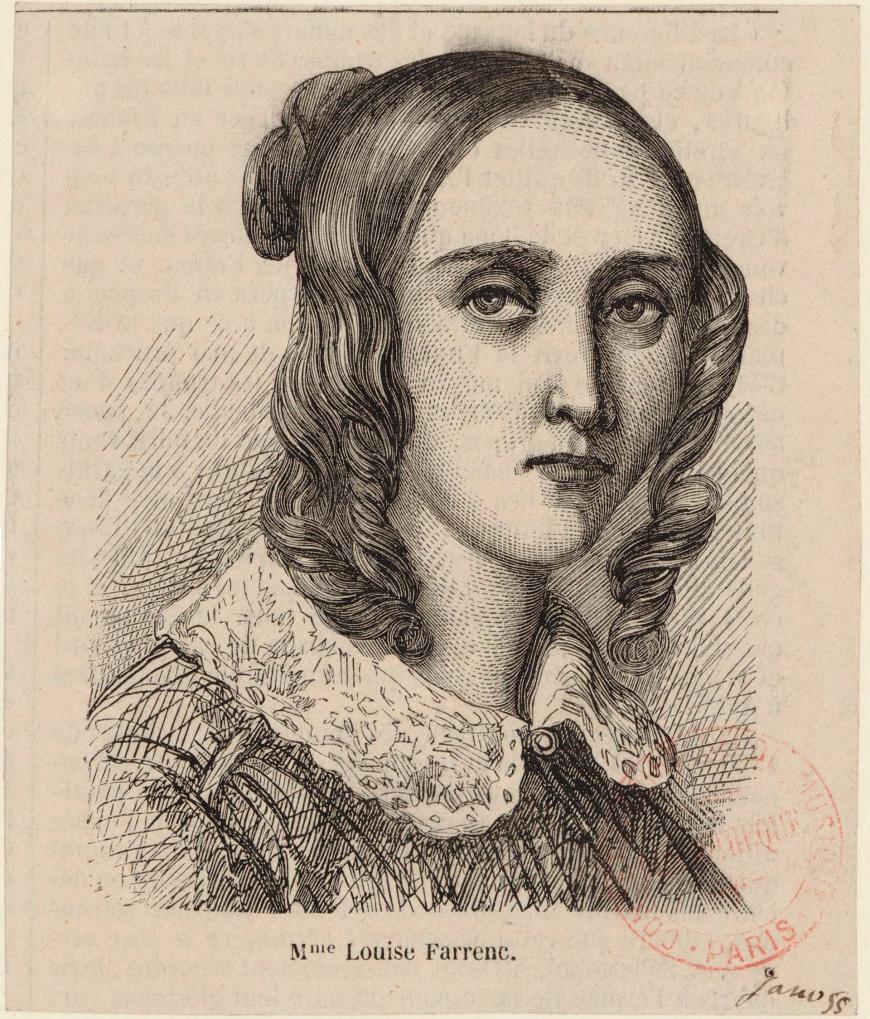
Jazz may be the quintessential American music, but its inventive harmonies and colors carry on a fruitful dialogue with French classical music, and that interaction built up a roaring head of steam at the Berkeley Symphony’s sold-out concert on Feb. 25. Music Director Joseph Young conducted, and his sibling, Robert, was the soloist in A Kind of Trane, a saxophone concerto by Guillaume Connesson honoring the great John Coltrane.
Also on the program were Claude Debussy’s revolutionary tone poem Prelude to the Afternoon of a Faun and the Symphony No. 3 by the long-neglected Louise Farrenc — one of the few women composers of 19th century France to garner acclaim from her contemporaries. Thus, the concert featured liberties, equalities, and fraternities aplenty and demonstrated the strong links of French traditions to outside influences.
If any piece symbolizes France’s musical freedom from the rest of Europe in the 1800s, it is Debussy’ sensuous and formally hazy orchestral tone poem evoking the love-dreams of a mythical faun. The highly familiar work remains remarkably fresh when performed with attention to Debussy’s extreme delicacy of instrumental color, which occurs without breaking the bounds of its miniature form — all the while borrowing Wagner’s free-flowing harmonies and larger-than-life passions.
In Sunday’s performance, the orchestra produced a muscular profile — in part because of its closeness to the audience amid the high-ceilinged acoustic of First Presbyterian Church in Berkeley. The famous opening flute solo was evocative and richly toned, as were many of the other wind solos, but they seemed unnaturally loud. The erotic swells of orchestral tuttis were similarly bold, and the spell of the conclusion was broken by startlingly prominent crotales.

The playing was excellent overall, but the effect was to awaken the man-goats among us. Even without any hush, the performance was captivating enough that its impact on jazz and on generations of French classical composers was unmistakable. Whether or not it was Joseph Young’s intent, the program firmly established the musical brotherhood of Debussy, Connesson, and Coltrane.
On then, to the vigors of jazz. Connesson is no revolutionary, but his saxophone concerto is a virtuosic tour-de-force honoring Coltrane’s restless search for new identities and rhythmic and harmonic freedom, elements that were iconic in the bebop transformation of jazz. Nobody was better at finding overlooked gaps in the musical fabric and seamlessly weaving unexpected notes in them.
Connesson’s A Kind of Trane has its own restlessness. The saxophonist relentlessly repeats interesting patterns and melodic ideas. Shifts are spare but meaningful, including between instruments (alto and soprano). The multiplicity of Coltrane’s voices and instruments are mirrored in the profusion of influences Connesson integrates as well as the strongly defined character of the three movements. Among the evident connections is French tradition, and the piece is not particularly jazzy — it is classical through and through. While Coltrane found melodic and harmonic inspirations in Debussy’s style, Connesson, too, paints the concerto with vivid instrumental color, yet he creates a new, contemporary kind of Trane with driving techno beats over hints of jazz and minimalist patterns.
Third Stream pioneers in the 1960s (think Gunther Schuller) tried to make classical pieces with jazz and jazz pieces with classical tendencies. By now, however, the two traditions fit so comfortably together that Connesson’s concerto is yet more proof of how accustomed classical ears are to music that draws from multiple sources. Equalities now exist in musical assimilation.
And so, A Kind of Trane tends toward tight collaboration between soloist and orchestra even when it mimics the driving soloist voice over big-band interjections. As a result, the stageless space was not kind to the soloist, and yet Robert Young brought it off perfectly. He was clear and pure-toned in the classical vein, with incredible focus and evenness. Young was also uncommonly expressive in lyrical passages and technically prodigious. The roaring standing ovation was inevitable after such a captivating show of musical intensity.

In music, luminaries like Debussy and Coltrane take giant steps across a landscape of fads and influences. Louise Farrenc had to light the way for others without the benefit of a profession that allowed equality of gender, Nonetheless, she crossed all the boundaries as a noted and respected teacher, performer, and composer. Most of her compositional brilliance is found in chamber and solo works for piano and for winds.
The symphony bears this stamp in part by highly distinctive and innovative melodic roles and balancing for the winds. Her contemporaries noted as much, and Farrenc’s music therefore charts a passage between the radical and, frankly, isolated symphonic achievement of Berlioz to Gabriel Faure and eventually to Connesson. Unlike Berlioz, Farrenc obviously paid close attention to Germanic examples from Mozart, Haydn, her teacher Anton Reicha, and especially Beethoven’s Symphony No. 3. In her symphonies, she remixed and instrumented in her own, distinctive terms, opening the way to more exploration of new instrumental colors, eventually by Debussy.
Under Joseph Young, the Berkeley Symphony sounded appropriately strong, lithe, and expressive, as befitting Farrenc’s music in the hands of a relatively middle-sized group (scaled to three basses). Young leaned into the unavoidably grand, heroic, and Germanic side of Farrenc’s symphony while allowing her irrepressibly varied colors to shine. The last movement was particularly impressive, propelled by Young’s rousing tempo.
Under Young’s capable leadership, this symphony, written on the cusp of the 1848 Revolution, clearly puts Farrenc in the growing sorority of groundbreaking French composers such as Elizabeth Jacquet de la Guerre (1665-1729), Cecile Chaminade (1857-1944), Lili Boulanger (1893-1918), Germaine Tailleferre (1892-1983), and Edith Canat de Chizy (1950-).



